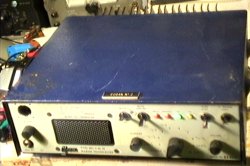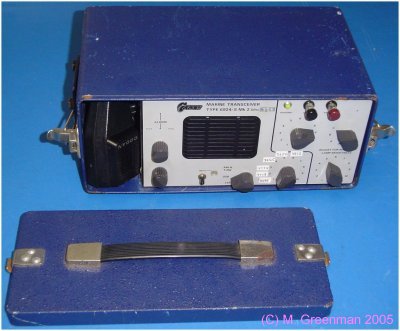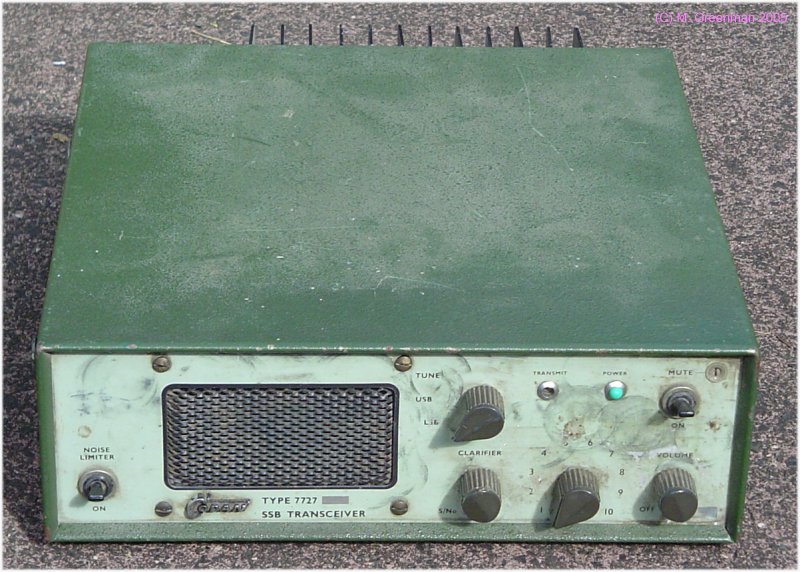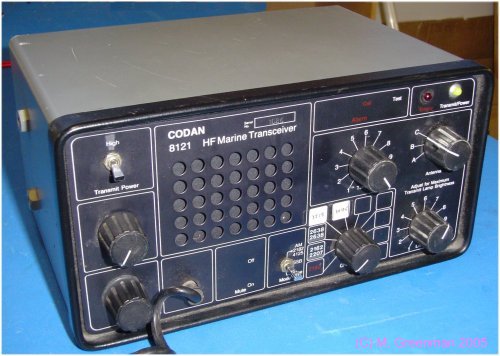Over the last 15 years or so, the commercial use of mobile HF radio has dwindled considerably. The same is true of marine MF/HF radio. As a result the older HF radios become redundant. VHF radio and cellular phone are now more popular - both becoming more viable with the maturity of the infrastructure involved.
Where do I find an HF SSB Radio?
Many end up in a junk heap at commercial radio repairers or marine agencies, and some can be found at Amateur Radio rallies, junk sales, or squirreled away in a friend's shack. Ask around! The type described here are the crystal-controlled 10-channel single conversion SSB type built in the 1970s and 1980s, which were widely used in Australia and New Zealand, and which represents the bulk of those available at sensible prices. You should be able to acquire one of these sets in good order for $40 or less. More recent synthesized commercial radios still command very high prices.
What can we do with these radios?
They make excellent spare HF radios, they are good for fixed links, great for setting up in the bach, boat or off-roader. Some of the smaller units make great portable sets. The larger units are easier to find, and have higher power - 100W - and additional features such as AM operation, a good noise blanker and excellent voice actuated squelch. Don't be put off because they are crystal controlled - this is why they are cheap to acquire, and there are several simple strategies for putting them on useful frequencies. Most of these radios will operate on 160m, 80m, 40m and 30m, and some will stretch as far as 20m. Even with just one working frequency, they can be very useful.
Note - These conversions are for Radio Amateurs only - most of these sets do not now meet land mobile
or marine type approval, and once you've made the suggested changes, they definitely will be for Amateurs Only!
No warranty of performance or suitability of these mods for Amateur or any other purpose is intended or provided.
About Type Approval
Commercial Radio and Marine Radio installations must use type approved and professionally installed equipment. Type approved sets should ONLY be set up, installed and adjusted by licenced technicians using factory approved parts. Once a radio falls outside the approvals, for whatever reason, it's value is reduced. That makes
it attractive for use on ham bands.
The CODAN models considered here are the most common types. All are rell built and reliable, and share a
common 1650kHz IF single conversion arrangement. Most have the renowned voice operated mute option. Since these radios have all been discontinued, parts are hard to find (especially channel selection coils), so you may need to use parts from a spare unit.
Service information and parts are no longer available from the manufacturer. No service manual or schematic information
is available from the author either, but can frequently be found on the web or various mobile radio forums.
Some links to photos, manuals and other information are provided.
No guarantee is given of the accuracy of the information given here or at any of the links.
6801
 Frequency Range
2 - 16MHz, 14 crystals
10 channel, single or two frequency simplex
Modes
SSB (A3J), USB with LSB option (extra filter)
AM (A3H), automatic AM on 2182kHz
Stability
�50Hz, -10�C to 50�C and �10% supply variation
Power Supply
12V, 10 - 15V (6801 Mk 2), 24V, 20 - 30V (6801-S Mk 2)
Receive, 250mA
A3J average voice transmit 6A (4A 24V)
A3H, A3J two tone transmit 13A (7A 24V)
Transmitter Output Power
100W PEP (120W 24V)
IF and Selectivity
Crystal Filter 1650kHz (SSB 300 - 2800Hz, 6dB; AM �3kHz 6dB)
SSB 70dB down at -1 and +4.2kHz
AM 60dB down at �14kHz
Dimensions
340 x 360 x 112mm, 5.6kg
Service Manual
Download Manual
Frequency Range
2 - 16MHz, 14 crystals
10 channel, single or two frequency simplex
Modes
SSB (A3J), USB with LSB option (extra filter)
AM (A3H), automatic AM on 2182kHz
Stability
�50Hz, -10�C to 50�C and �10% supply variation
Power Supply
12V, 10 - 15V (6801 Mk 2), 24V, 20 - 30V (6801-S Mk 2)
Receive, 250mA
A3J average voice transmit 6A (4A 24V)
A3H, A3J two tone transmit 13A (7A 24V)
Transmitter Output Power
100W PEP (120W 24V)
IF and Selectivity
Crystal Filter 1650kHz (SSB 300 - 2800Hz, 6dB; AM �3kHz 6dB)
SSB 70dB down at -1 and +4.2kHz
AM 60dB down at �14kHz
Dimensions
340 x 360 x 112mm, 5.6kg
Service Manual
Download Manual
The 6801 is a large but very flexible unit, easy to work on. It has noise blanker, voice activated mute, and a very conservatively rated power amplifier. It comes in a green and cream colour scheme or nautical blue and grey. There is space on the RF/IF board for THREE crystal filters! The 24V marine version is usually cheaper, and
gives a bit more output power. Apparently they can be 12V converted by simply rewinding PA transformers.
6924 Mk 2
 Frequency Range
2 - 13MHz, 10 crystals
10 channel, single or two frequency simplex
Modes
SSB (A3J), USB with LSB option
AM (A3H), automatic AM on 2182kHz with option
Any two of USB, LSB, AM modes possible
Stability
�50Hz, -10�C to 50�C and �10% supply variation
Power Supply
12V, 10.5 - 15V (case isolated)
Receive, 100mA
A3J average voice transmit 2A
A3H, A3J two tone transmit 3.5A
Transmitter Output Power
30W PEP (6924-S 35W)
8W AM (6924-S 9W)
Antenna
Whip or long-wire from 2.4m to 25m at any
frequency within operating range
IF and Selectivity
Crystal Filter 1650kHz
SSB 300 - 2800Hz, 6dB
SSB 70dB down at -1 and +4.2kHz
AM �3kHz, 6dB
AM 60dB down at �12.5kHz
Image rejection >65dB
Dimensions
313 x 193 x 125mm, 4.7kg
More Pictures
Larger general view
Closer general view
Front panel
Inside view
Internal view with hinge-out section open
The 6924 Mk 1
Frequency Range
2 - 13MHz, 10 crystals
10 channel, single or two frequency simplex
Modes
SSB (A3J), USB with LSB option
AM (A3H), automatic AM on 2182kHz with option
Any two of USB, LSB, AM modes possible
Stability
�50Hz, -10�C to 50�C and �10% supply variation
Power Supply
12V, 10.5 - 15V (case isolated)
Receive, 100mA
A3J average voice transmit 2A
A3H, A3J two tone transmit 3.5A
Transmitter Output Power
30W PEP (6924-S 35W)
8W AM (6924-S 9W)
Antenna
Whip or long-wire from 2.4m to 25m at any
frequency within operating range
IF and Selectivity
Crystal Filter 1650kHz
SSB 300 - 2800Hz, 6dB
SSB 70dB down at -1 and +4.2kHz
AM �3kHz, 6dB
AM 60dB down at �12.5kHz
Image rejection >65dB
Dimensions
313 x 193 x 125mm, 4.7kg
More Pictures
Larger general view
Closer general view
Front panel
Inside view
Internal view with hinge-out section open
The 6924 Mk 1
The 6924 Mk 2 is a small portable unit in a rainproof "lunch box" with clip-on lid and built-in antenna tuner.
A small compartment on the left side gives storage space for the microphone.
The antenna and ground push-terminal connections are on the front panel. Colours are green and cream (6924 Mk 2) or blue and grey (6924-S Mk 2). The units are engineering masterpieces and easy to work on. An ideal radio for
solar power supply (note receiver current).
The 6924 Mk 2 has been used in many out of the way places - off-shore islands, Antarctica, and throughout
the Pacific. The author's unit spent most of
its life on Little Barrier Island, callsign ZKMP7, in a Department of Conservation hut, powered by solar energy.
The older 6924 Mk 1
has a different arrangement both inside and out, and uses an inverter to power the transmitter. It is difficult to
work on and not reconmmended.
7727
 Frequency Range
2 - 16MHz, 10 crystals
10 channel, single or two frequency simplex
Modes
SSB (A3J), USB with LSB option
AM (A3H), automatic AM on 2182kHz
Stability
�50Hz, -10�C to 50�C and �10% supply variation
Power Supply
12V: 10 - 15V, 24V: 20 - 30V
Receive, 250mA
A3J average voice transmit 5A (3A 24V)
A3H, A3J two tone transmit 11A (6A 24V)
Transmitter Output Power
100W PEP
IF and Selectivity
Crystal Filter 1650kHz
SSB 300 - 2800Hz, 6dB
SSB 70dB down at -1 and +4.2kHz
AM �3kHz, 6dB
AM 60dB down at �14kHz
Dimensions
325 x 270 x 95mm, 4.5kg
Service Manual
Download Manual
More Pictures
Remote Control Version 7727TB
Marine Version
Frequency Range
2 - 16MHz, 10 crystals
10 channel, single or two frequency simplex
Modes
SSB (A3J), USB with LSB option
AM (A3H), automatic AM on 2182kHz
Stability
�50Hz, -10�C to 50�C and �10% supply variation
Power Supply
12V: 10 - 15V, 24V: 20 - 30V
Receive, 250mA
A3J average voice transmit 5A (3A 24V)
A3H, A3J two tone transmit 11A (6A 24V)
Transmitter Output Power
100W PEP
IF and Selectivity
Crystal Filter 1650kHz
SSB 300 - 2800Hz, 6dB
SSB 70dB down at -1 and +4.2kHz
AM �3kHz, 6dB
AM 60dB down at �14kHz
Dimensions
325 x 270 x 95mm, 4.5kg
Service Manual
Download Manual
More Pictures
Remote Control Version 7727TB
Marine Version
The 7727 comes in many versions, 12V/24V, marine and land mobile, local control and remote control. It comes
in a green and cream colour scheme, black and grey, or nautical blue and grey. Above you see the land mobile version. The 7727TB (remote control version) is especially attractive as it has relay-operated channel change
and so can be arranged for automatic band-change when using a local or remote micro controller and digital VFO.
8121
 Frequency Range
2 - 13.2MHz, 10 crystals
10 channel, single or two frequency simplex
Modes
SSB (A3J), USB
AM (A3H), automatic AM on 2182kHz with option
Stability
�50Hz, -10�C to 50�C amd �10% supply variation
Power Supply
12V, 10 - 15V
Receive, 100mA
A3J average voice transmit 2.5A
A3H, A3J two tone transmit 6A
Transmitter Output Power
60W PEP (15W AM) 2 - 9MHz
45W PEP (15W AM) 9 - 13.2MHz
Antenna
Whip or long-wire from 2.4m to 25m at any
frequency within operating range (approx 1/16 to 1/4 wavelength)
IF and Selectivity
Crystal Filter 1650kHz (SSB 300 - 2800Hz, 6dB; AM �3kHz 6dB)
SSB 70dB down at -1 and +4.2kHz
AM 60dB down at �12.5kHz
Dimensions
280 x 212 x 140mm, 3.6kg
More Pictures
Larger general view
Front panel
Rear view
Frequency Range
2 - 13.2MHz, 10 crystals
10 channel, single or two frequency simplex
Modes
SSB (A3J), USB
AM (A3H), automatic AM on 2182kHz with option
Stability
�50Hz, -10�C to 50�C amd �10% supply variation
Power Supply
12V, 10 - 15V
Receive, 100mA
A3J average voice transmit 2.5A
A3H, A3J two tone transmit 6A
Transmitter Output Power
60W PEP (15W AM) 2 - 9MHz
45W PEP (15W AM) 9 - 13.2MHz
Antenna
Whip or long-wire from 2.4m to 25m at any
frequency within operating range (approx 1/16 to 1/4 wavelength)
IF and Selectivity
Crystal Filter 1650kHz (SSB 300 - 2800Hz, 6dB; AM �3kHz 6dB)
SSB 70dB down at -1 and +4.2kHz
AM 60dB down at �12.5kHz
Dimensions
280 x 212 x 140mm, 3.6kg
More Pictures
Larger general view
Front panel
Rear view
The 8121 is a small marine radio, with internal tuner and permanently connected microphone. The antenna connector stud and ground stud are on the back panel. It is intended for use with a random wire, untuned whip or backstay antenna.
It comes in boatie black with white decals. The case is splash-proof and there is no external heatsink.
Although a higher-powered amplifier is used, internally it is very similar to the 6924 Mk 2, and easy to work on.
The standard 8121 lacks the Mute circuit, but it is easily added.
This model illustrates the remarkable
longevity of the core design - 1969 to the mid-80's, and many of these radios are still in use today.



